
Question Number 5190 by sanusihammed last updated on 28/Apr/16

Commented by prakash jain last updated on 29/Apr/16
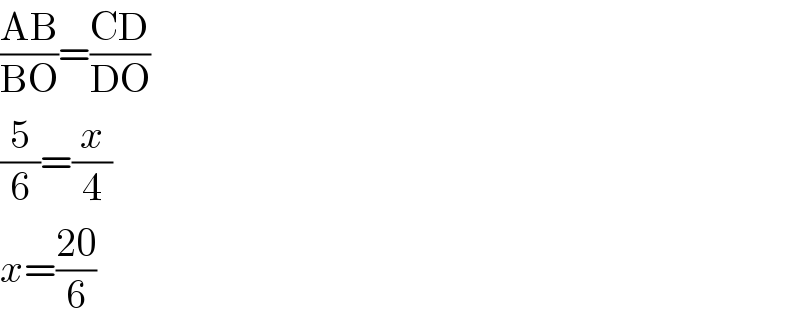
$$\frac{\mathrm{AB}}{\mathrm{BO}}=\frac{\mathrm{CD}}{\mathrm{DO}} \\ $$$$\frac{\mathrm{5}}{\mathrm{6}}=\frac{{x}}{\mathrm{4}} \\ $$$${x}=\frac{\mathrm{20}}{\mathrm{6}} \\ $$
Commented by Rasheed Soomro last updated on 01/May/16

$$\mathrm{Is}\:\mathrm{there}\:\mathrm{a}\:\mathrm{guarantee}\:\mathrm{that}\:\mathrm{AC}\:\parallel\:\mathrm{BD}\:? \\ $$
Commented by Rasheed Soomro last updated on 02/May/16
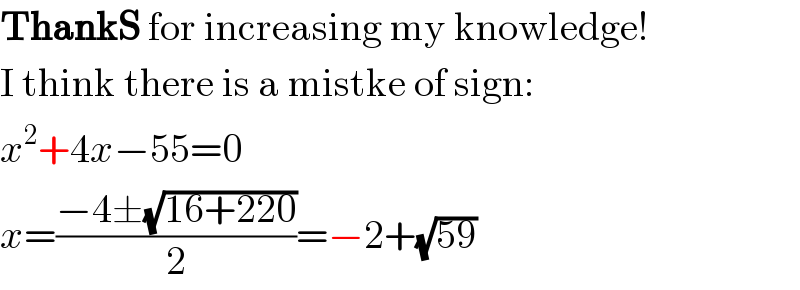
$$\boldsymbol{\mathrm{ThankS}}\:\mathrm{for}\:\mathrm{increasing}\:\mathrm{my}\:\mathrm{knowledge}! \\ $$$$\mathrm{I}\:\mathrm{think}\:\mathrm{there}\:\mathrm{is}\:\mathrm{a}\:\mathrm{mistke}\:\mathrm{of}\:\mathrm{sign}: \\ $$$${x}^{\mathrm{2}} +\mathrm{4}{x}−\mathrm{55}=\mathrm{0} \\ $$$${x}=\frac{−\mathrm{4}\pm\sqrt{\mathrm{16}+\mathrm{220}}}{\mathrm{2}}=−\mathrm{2}+\sqrt{\mathrm{59}} \\ $$
Commented by prakash jain last updated on 01/May/16
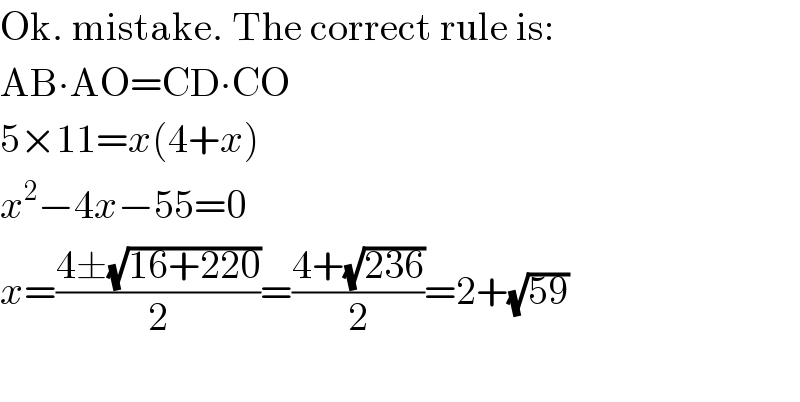
$$\mathrm{Ok}.\:\mathrm{mistake}.\:\mathrm{The}\:\mathrm{correct}\:\mathrm{rule}\:\mathrm{is}: \\ $$$$\mathrm{AB}\centerdot\mathrm{AO}=\mathrm{CD}\centerdot\mathrm{CO} \\ $$$$\mathrm{5}×\mathrm{11}={x}\left(\mathrm{4}+{x}\right) \\ $$$${x}^{\mathrm{2}} −\mathrm{4}{x}−\mathrm{55}=\mathrm{0} \\ $$$${x}=\frac{\mathrm{4}\pm\sqrt{\mathrm{16}+\mathrm{220}}}{\mathrm{2}}=\frac{\mathrm{4}+\sqrt{\mathrm{236}}}{\mathrm{2}}=\mathrm{2}+\sqrt{\mathrm{59}} \\ $$$$ \\ $$
Commented by prakash jain last updated on 02/May/16

$$\mathrm{Yes}.\:\mathrm{Thanks}\:\mathrm{for}\:\mathrm{correction}. \\ $$
Answered by prakash jain last updated on 29/Apr/16
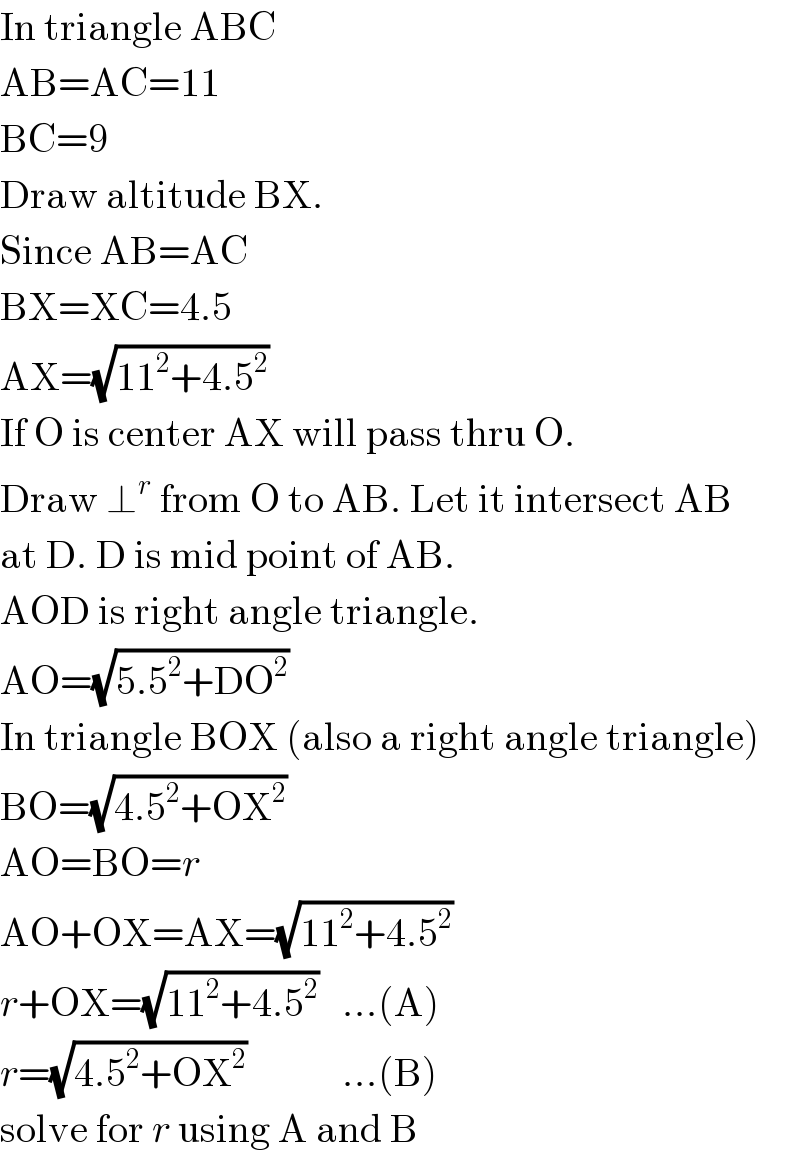
$$\mathrm{In}\:\mathrm{triangle}\:\mathrm{ABC} \\ $$$$\mathrm{AB}=\mathrm{AC}=\mathrm{11} \\ $$$$\mathrm{BC}=\mathrm{9} \\ $$$$\mathrm{Draw}\:\mathrm{altitude}\:\mathrm{BX}.\: \\ $$$$\mathrm{Since}\:\mathrm{AB}=\mathrm{AC} \\ $$$$\mathrm{BX}=\mathrm{XC}=\mathrm{4}.\mathrm{5} \\ $$$$\mathrm{AX}=\sqrt{\mathrm{11}^{\mathrm{2}} +\mathrm{4}.\mathrm{5}^{\mathrm{2}} } \\ $$$$\mathrm{If}\:\mathrm{O}\:\mathrm{is}\:\mathrm{center}\:\mathrm{AX}\:\mathrm{will}\:\mathrm{pass}\:\mathrm{thru}\:\mathrm{O}. \\ $$$$\mathrm{Draw}\:\bot^{{r}} \:\mathrm{from}\:\mathrm{O}\:\mathrm{to}\:\mathrm{AB}.\:\mathrm{Let}\:\mathrm{it}\:\mathrm{intersect}\:\mathrm{AB} \\ $$$$\mathrm{at}\:\mathrm{D}.\:\mathrm{D}\:\mathrm{is}\:\mathrm{mid}\:\mathrm{point}\:\mathrm{of}\:\mathrm{AB}. \\ $$$$\mathrm{AOD}\:\mathrm{is}\:\mathrm{right}\:\mathrm{angle}\:\mathrm{triangle}. \\ $$$$\mathrm{AO}=\sqrt{\mathrm{5}.\mathrm{5}^{\mathrm{2}} +\mathrm{DO}^{\mathrm{2}} } \\ $$$$\mathrm{In}\:\mathrm{triangle}\:\mathrm{BOX}\:\left(\mathrm{also}\:\mathrm{a}\:\mathrm{right}\:\mathrm{angle}\:\mathrm{triangle}\right) \\ $$$$\mathrm{BO}=\sqrt{\mathrm{4}.\mathrm{5}^{\mathrm{2}} +\mathrm{OX}^{\mathrm{2}} } \\ $$$$\mathrm{AO}=\mathrm{BO}={r} \\ $$$$\mathrm{AO}+\mathrm{OX}=\mathrm{AX}=\sqrt{\mathrm{11}^{\mathrm{2}} +\mathrm{4}.\mathrm{5}^{\mathrm{2}} } \\ $$$${r}+\mathrm{OX}=\sqrt{\mathrm{11}^{\mathrm{2}} +\mathrm{4}.\mathrm{5}^{\mathrm{2}} }\:\:\:...\left(\mathrm{A}\right) \\ $$$${r}=\sqrt{\mathrm{4}.\mathrm{5}^{\mathrm{2}} +\mathrm{OX}^{\mathrm{2}} }\:\:\:\:\:\:\:\:\:\:\:\:...\left(\mathrm{B}\right) \\ $$$$\mathrm{solve}\:\mathrm{for}\:{r}\:\mathrm{using}\:\mathrm{A}\:\mathrm{and}\:\mathrm{B} \\ $$
Answered by Rasheed Soomro last updated on 01/May/16
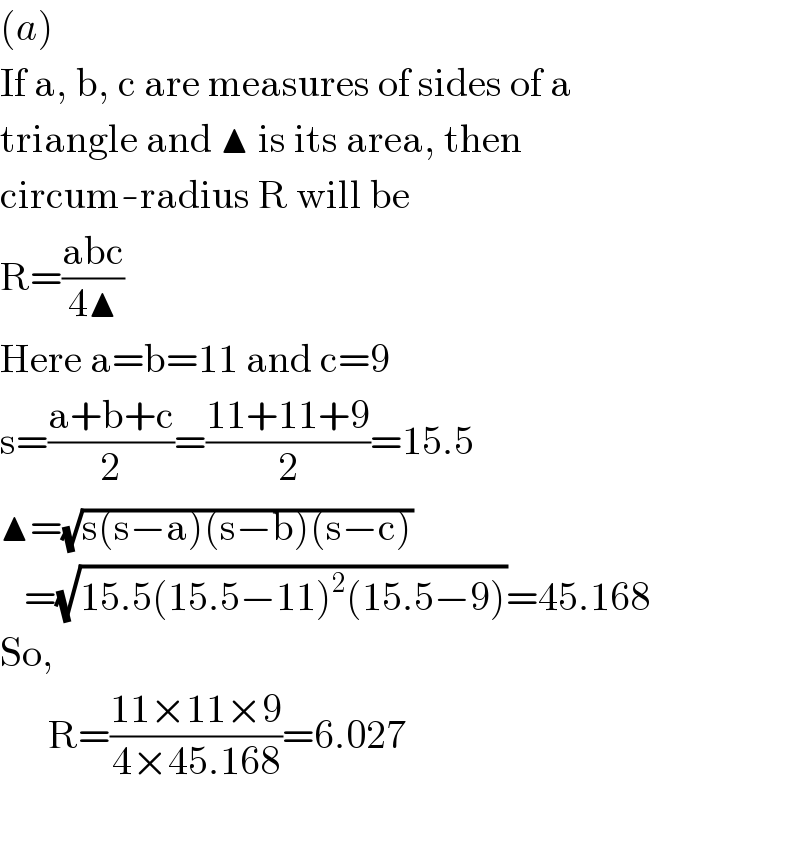
$$\left({a}\right) \\ $$$$\mathrm{If}\:\mathrm{a},\:\mathrm{b},\:\mathrm{c}\:\mathrm{are}\:\mathrm{measures}\:\mathrm{of}\:\mathrm{sides}\:\mathrm{of}\:\mathrm{a} \\ $$$$\mathrm{triangle}\:\mathrm{and}\:\blacktriangle\:\mathrm{is}\:\mathrm{its}\:\mathrm{area},\:\mathrm{then} \\ $$$$\mathrm{circum}-\mathrm{radius}\:\mathrm{R}\:\mathrm{will}\:\mathrm{be} \\ $$$$\mathrm{R}=\frac{\mathrm{abc}}{\mathrm{4}\blacktriangle} \\ $$$$\mathrm{Here}\:\mathrm{a}=\mathrm{b}=\mathrm{11}\:\mathrm{and}\:\mathrm{c}=\mathrm{9} \\ $$$$\mathrm{s}=\frac{\mathrm{a}+\mathrm{b}+\mathrm{c}}{\mathrm{2}}=\frac{\mathrm{11}+\mathrm{11}+\mathrm{9}}{\mathrm{2}}=\mathrm{15}.\mathrm{5} \\ $$$$\blacktriangle=\sqrt{\mathrm{s}\left(\mathrm{s}−\mathrm{a}\right)\left(\mathrm{s}−\mathrm{b}\right)\left(\mathrm{s}−\mathrm{c}\right)} \\ $$$$\:\:\:=\sqrt{\mathrm{15}.\mathrm{5}\left(\mathrm{15}.\mathrm{5}−\mathrm{11}\right)^{\mathrm{2}} \left(\mathrm{15}.\mathrm{5}−\mathrm{9}\right)}=\mathrm{45}.\mathrm{168} \\ $$$$\mathrm{So}, \\ $$$$\:\:\:\:\:\:\mathrm{R}=\frac{\mathrm{11}×\mathrm{11}×\mathrm{9}}{\mathrm{4}×\mathrm{45}.\mathrm{168}}=\mathrm{6}.\mathrm{027} \\ $$$$ \\ $$
